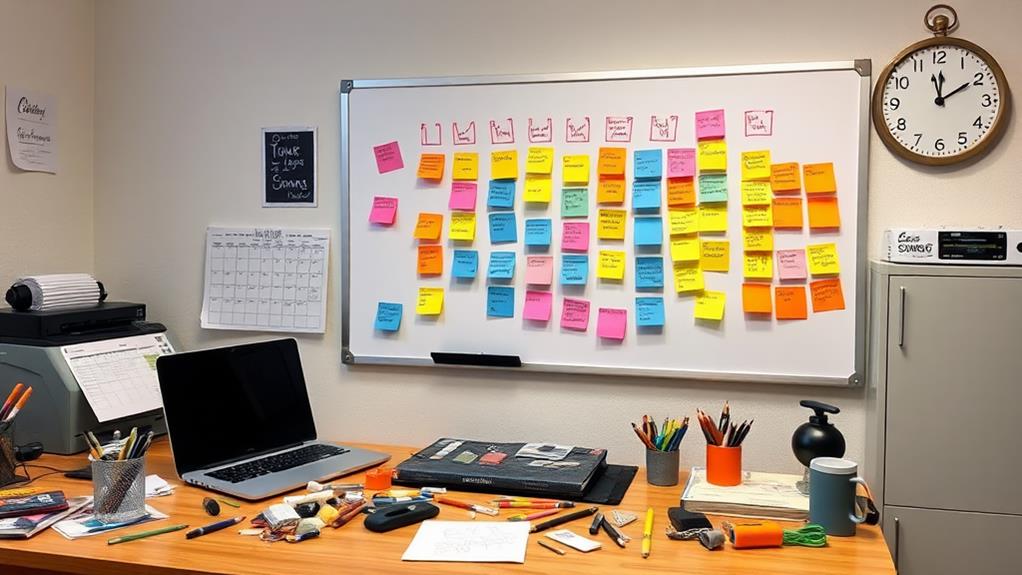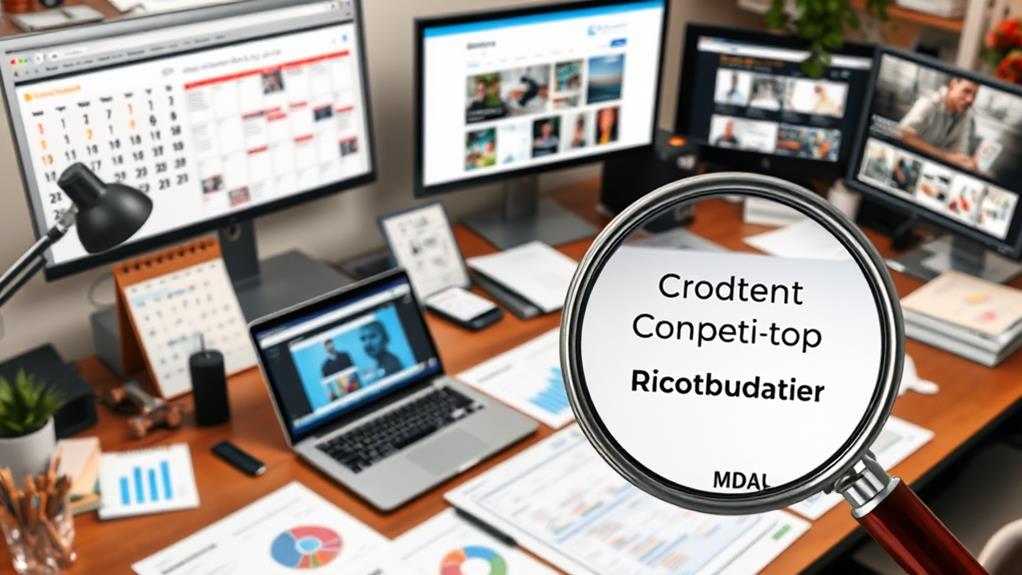Developing a content calendar for office equipment marketing involves a strategic approach to planning, creating, and distributing relevant content across various platforms. The process begins with defining content themes that align with the target audience's needs and the company's expertise. Next, a publishing schedule is established, considering ideal frequency and resource capabilities. Content creators are then assigned based on their expertise and availability. This structured approach offers numerous benefits, including consistent brand messaging, improved resource allocation, and enhanced team collaboration. By implementing a well-organized content calendar, office equipment marketers can effectively engage their audience and achieve their marketing objectives. Further exploration of this topic will reveal additional strategies for optimizing content creation and distribution.
Office Equipment Highlights
- Define content themes aligned with office equipment trends, customer pain points, and product offerings.
- Set a consistent publishing schedule across various platforms, considering audience habits and resource capabilities.
- Assign content creation tasks based on team members' expertise in specific office equipment areas.
- Maintain consistent brand messaging to position your company as a trusted office equipment partner.
- Allocate resources efficiently by planning content around product launches, industry events, and business objectives.
Content Calendar Creation Process

Creating an effective content calendar for office equipment marketing involves several pivotal steps. The process begins with defining content themes that align with your marketing goals and target audience's interests, ensuring a cohesive and strategic approach to your content creation efforts.
Next, establishing a publishing schedule that balances consistency with resource availability is essential, taking into account factors such as peak engagement times and seasonal trends. Incorporating exclusive lead generation strategies into your content calendar can help increase sales and grow your business. This approach allows you to target specific areas and tailor your content accordingly.
Define Content Themes
When establishing a content calendar for office equipment marketing, defining content themes is a crucial step in the creation process. These themes serve as the foundation for your content strategy, guaranteeing consistency and relevance across all marketing efforts. To begin, analyze your target audience's needs, pain points, and interests, aligning them with your company's expertise and product offerings. Consider themes such as productivity enhancement, cost-efficiency, ergonomics, sustainability, and technological advancements in office equipment.
Once identified, organize these themes into broader categories, such as "Workplace Efficiency" or "Sustainable Office Solutions." This categorization will help structure your content and provide a cohesive narrative throughout your marketing calendar. Additionally, consider incorporating seasonality and industry trends into your themes, allowing for timely and relevant content creation. For example, focus on tax season preparation for accounting firms or back-to-school equipment for educational institutions.
Set Publishing Schedule
The backbone of a successful content marketing strategy lies in establishing a consistent publishing schedule. When setting this schedule for office equipment marketing, it's pivotal to contemplate the target audience's habits, content consumption patterns, and the company's resource capabilities. A well-structured publishing plan guarantees that your team can consistently deliver high-quality content, fostering a sense of reliability and anticipation among your audience.
To create an effective publishing schedule, start by determining the ideal frequency for each content type, such as blog posts, social media updates, and email newsletters. Consider factors like industry trends, seasonal fluctuations in office equipment demand, and your team's capacity to produce content.
It's advisable to create a content calendar that outlines specific publication dates, content themes, and assigned responsibilities for each piece. This approach allows for better planning, resource allocation, and coordination among team members. Additionally, incorporating buffer time for unexpected delays or last-minute adjustments can help maintain consistency in your publishing efforts.
Assign Content Creators
After establishing a publishing schedule, the next essential step in developing a content calendar for office equipment marketing is assigning content creators. This process involves carefully selecting individuals or teams responsible for producing various content pieces, ensuring a cohesive and consistent message across all marketing channels. When assigning creators, it is imperative to consider their expertise, availability, and familiarity with the office equipment industry.
The content creation team may include in-house marketing professionals, subject matter experts from different departments, and external freelancers or agencies specializing in office equipment marketing. Each content piece should be allocated to the most suitable creator based on their skills and knowledge. For instance, technical specifications and product comparisons may be assigned to product managers or engineers, while blog posts and social media content could be delegated to marketing writers.
It is necessary to clearly communicate expectations, deadlines, and content guidelines to each creator, ensuring they understand their role in the overall marketing strategy. Additionally, implementing a review and approval process helps maintain quality control and consistency across all content pieces, fostering a sense of collaboration and shared responsibility among team members.
Benefits

A well-crafted content calendar for office equipment marketing offers numerous advantages that can vastly improve a company's marketing efforts. By implementing a structured content plan, businesses can guarantee consistent brand messaging across all platforms, allocate resources more efficiently, and foster improved collaboration among team members.
Strategies can be seamlessly integrated into the calendar, allowing for the creation of engaging and informative content optimized for search engine visibility. Additionally, a content calendar enables strategic planning of marketing initiatives, allowing companies to align their content with important industry events, product launches, and seasonal trends, ultimately maximizing the impact of their marketing campaigns.
Consistent Brand Messaging
Maintaining consistent brand messaging across all marketing efforts pays off in numerous ways for office equipment companies. A content calendar guarantees that the brand's voice, tone, and key messages remain uniform across various platforms and campaigns, reinforcing the company's identity and values. This consistency helps build trust and familiarity among potential clients, who come to recognize and relate to the brand's unique personality. In addition, it fosters a sense of belonging among existing customers, who feel part of a cohesive community that shares common values and aspirations.
When crafting content for office equipment marketing, it is essential to align all communications with the established brand guidelines. This includes using consistent visual elements, such as logos, color schemes, and typography, as well as maintaining a unified writing style and tone of voice. By doing so, companies can create a strong, recognizable presence in the market, differentiating themselves from competitors and increasing brand recall. Additionally, consistent messaging helps reinforce the company's expertise and reliability, positioning it as a trusted partner in the office equipment industry. This approach ultimately leads to increased customer loyalty, improved brand perception, and enhanced overall marketing effectiveness.
Improved Resource Allocation
One of the significant benefits of implementing a content calendar for office equipment marketing is improved resource allocation. By planning content in advance, companies can strategically distribute their human and financial resources across various marketing initiatives, ensuring a balanced and effective approach. This systematic planning allows for the identification of potential resource gaps or overlaps, enabling marketing teams to make informed decisions about where to focus their efforts and investments.
With a well-structured content calendar, organizations can align their marketing activities with broader business objectives, product launches, and industry events. This alignment facilitates a more efficient use of resources, as teams can prepare materials in advance, avoiding last-minute rushes and associated costs. Additionally, the calendar provides a clear overview of upcoming content needs, allowing for the timely allocation of writers, designers, and other creative professionals.
Enhanced Team Collaboration
Frequently, a well-implemented content calendar for office equipment marketing fosters enhanced team collaboration, yielding numerous benefits for the organization. By providing a centralized platform for planning, coordinating, and executing marketing initiatives, a content calendar streamlines communication and aligns team efforts. This collaborative approach guarantees that all team members are working in tandem towards shared goals, maximizing efficiency and productivity.
The enhanced team collaboration facilitated by a content calendar offers several key advantages:
- Improved accountability and task ownership
- Seamless integration of diverse skill sets and expertise
- Increased transparency in project progress and deadlines
- Enhanced cross-functional cooperation and idea-sharing
Furthermore, the collaborative nature of a content calendar encourages a sense of unity among team members, fostering a culture of mutual support and shared success. As individuals contribute their unique perspectives and strengths to the collective effort, the quality and effectiveness of marketing campaigns improve enormously. This synergistic approach not only enhances the overall output but also cultivates a more cohesive and motivated workforce, ultimately leading to better results in office equipment marketing initiatives.
Strategic Content Planning
Strategic content planning's benefits extend far beyond mere organization in office equipment marketing. By implementing a well-structured approach, companies can align their marketing efforts with overarching business objectives, ensuring that every piece of content serves a specific purpose. This alignment allows for the creation of cohesive campaigns that resonate with target audiences, fostering a sense of connection and understanding among potential clients.
Furthermore, strategic content planning enables marketers to anticipate industry trends, seasonal demands, and product launches, positioning the company as a forward-thinking leader in the office equipment sector. By mapping out content in advance, teams can allocate resources more efficiently, reducing last-minute scrambles and improving overall quality. This proactive stance also facilitates better coordination between departments, such as sales and product development, ensuring that marketing messages are consistent and reflective of the company's latest offerings.
Additionally, a well-planned content strategy allows for the identification of gaps in messaging, enabling marketers to address all aspects of the buyer's journey thoroughly. Ultimately, strategic content planning enhances the effectiveness of marketing efforts, driving engagement, lead generation, and conversions in the competitive office equipment marketplace.
Analyzing Competitor Content Strategies

Analyzing competitor content strategies is a vital step in developing an effective content calendar for office equipment marketing. By identifying key competitors and evaluating their content types, marketers can gain valuable insights into industry trends and consumer preferences. This analysis also helps uncover content gaps, presenting opportunities for differentiation and innovation in the company's own marketing efforts.
| Competitor Analysis Steps | Benefits |
|---|---|
| Identify Key Competitors | Understand market landscape |
| Evaluate Content Types | Recognize successful formats |
| Assess Content Frequency | Determine ideal publishing schedule |
| Uncover Content Gaps | Identify unique opportunities |
Identify Key Competitors
Competitor analysis forms the backbone of any effective content strategy for office equipment marketing. To develop a thorough understanding of the competitive landscape, it is vital to identify key competitors in the industry. This process involves researching and cataloging companies that offer similar products or services, as well as those targeting the same customer base.
When identifying key competitors, consider the following factors:
- Market share and revenue
- Product range and specialization
- Geographic presence and target markets
- Online visibility and content marketing efforts
Evaluate Content Types
With key competitors identified, the next step in developing a robust content calendar for office equipment marketing is to evaluate the various types of content these competitors are producing. This analysis involves a thorough review of their online presence, including blog posts, social media updates, videos, infographics, and whitepapers.
By examining the format, frequency, and engagement levels of their content, marketers can gain valuable insights into what resonates with the target audience.
During this evaluation process, it is essential to assess the quality, depth, and relevance of the content being shared. Attention should be paid to the topics covered, the tone of voice employed, and the calls-to-action utilized. Additionally, marketers should consider how competitors are leveraging different platforms to distribute their content and engage with their audience.
This analysis may reveal gaps in the market that can be exploited or highlight successful strategies that can be adapted and improved upon. By thoroughly evaluating competitors' content types, marketers can make informed decisions about the most effective formats and topics to include in their own content calendar, ensuring a competitive edge in the office equipment market.
Uncover Content Gaps
Content gap analysis forms the cornerstone of a successful office equipment marketing strategy. By meticulously examining competitors' content and comparing it to your own, you can identify areas where your marketing efforts may be lacking or where opportunities exist to differentiate your brand. This process involves an extensive review of various content types, topics, and formats across multiple platforms, enabling you to pinpoint gaps in your current strategy and develop a plan to address them.
To effectively uncover content gaps, consider the following key areas:
- Keyword coverage and search engine rankings
- Topic breadth and depth within your industry niche
- Content formats (e.g., blog posts, videos, infographics)
- Target audience segments and their specific needs
Office Equipment FAQ
How Often Should I Update My Content Calendar?
To stay aligned with your team's goals, update your content calendar regularly. Monthly revisions allow for timely adjustments while maintaining consistency. However, weekly check-ins can help you stay agile and responsive to emerging trends or opportunities.
What Tools Can I Use to Manage My Content Calendar?
For managing your content calendar, several user-friendly tools are available to our team. Popular options include Trello, Asana, CoSchedule, and Google Calendar. These platforms offer collaborative features, helping us stay organized and aligned with our shared content goals.
How Do I Measure the Success of My Content Calendar?
To measure your content calendar's success, track key performance indicators like engagement rates, conversions, and website traffic. Analyze audience growth and feedback. Regularly review and adjust your strategy based on these metrics to guarantee continuous improvement and connection with your community.
Should I Include Social Media Posts in My Content Calendar?
Including social media posts in your content calendar is essential for an all-encompassing strategy. It allows you to plan and coordinate your messaging across platforms, ensuring consistency and maximizing engagement with your community of followers and potential customers.
How Far in Advance Should I Plan My Content Calendar?
Planning your content calendar 3-6 months in advance is ideal for our team. This approach allows us to align with our goals, stay ahead of trends, and maintain flexibility. It's a balance that keeps us organized and responsive.


Recent Comments